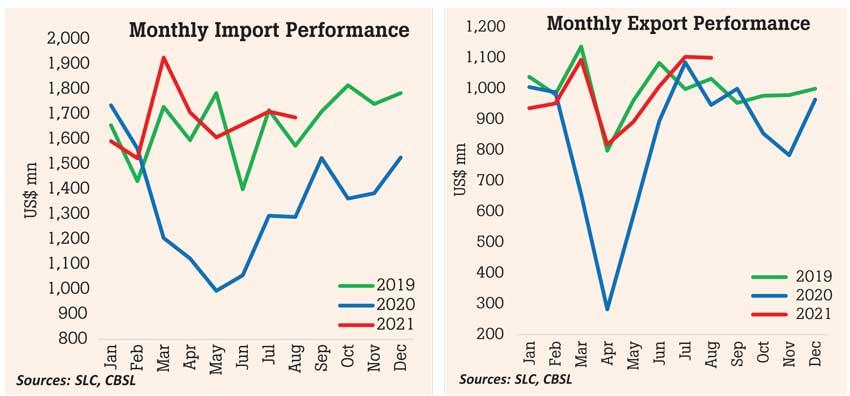Reply To:
Name - Reply Comment

The merchandise imports surged in August, significantly outstripping the increase in exports, as global oil prices climbed while the importers raced to place more orders for goods than they typically do, concerned by the prevailing foreign exchange, prompting the authorities to step into curtail some selected imports in the following month.
According to the Central Bank data, Sri Lanka had spent US $ 1,687 million on imports in August 2021, up 30.8 percent from the same month last year, while the exports rose by 16.2 percent to US $ 1,100 million, marking the third consecutive such month of over a billion dollar in earnings.
This expanded the country’s trade deficit to US $ 586 million in August, from US $ 342 million a year ago, with the cumulative eight-month deficit widening to US $ 5,509 million, from US $ 3,812 million in the corresponding eight months in 2020. In the eight months, the cumulative imports jumped 30.7 percent to US $ 13, 411 million while the exports trailed at US $ 7,903 million, rising by 22.6 percent over the same period, last year.
While the rapid increase in global crude oil prices, imports of machinery and equipment, textiles and textiles articles, base metals and chemical products contributed the most to the August trade deficit, a section of economists attribute the current expansionary monetary policy to the widening trade deficit. They cite the money injected into the system by the Central Bank for deficit financing of the government and the private sector credit issued by the banking sector have ended up creating more demand for imported goods and services, invariably resulting in higher imports and thereby the wider deficit in the trade account.
People also spend on imports the money they receive as worker remittances and other services exports such as IT/BPO and tourism, sparking more demand for imported merchandise, as there is a limited domestic production at home and most of the goods are imported, including some essentials. This was reflected from the short spell from August through September, when the country was on the brink of a food scarcity, creating long lines in front of retail outlets to obtain rationed essentials, when some imports such as milk powder, sugar, cooking gas and the likes were in short supply, due to the foreign currency shortage.
Nevertheless, the August terms of trade reflected that much of the import bill was caused by the soaring global commodities prices than the volume increase in imports to Sri Lanka. For instance, the import volumes have risen by a paltry 3.6 percent from a year ago but the prices have risen by a sharp 26.3 percent, causing much of the expenditure on imports to result from the price effect.
Sri Lanka’s August oil import bill rose by 42.5 percent to US $ 352.7 million in August from a year ago, solely due to the sharp increase in global crude oil prices from US $ 47.74 a barrel to US $ 74.88 a barrel between the two years, while the volume imports had declined.
Conversely, Sri Lanka’s exporters haven’t benefitted much from the rising global commodities prices as export prices have risen by only 2.0 percent in August from a year ago, indicating that much of the export earnings have been driven by the increase in volumes as reflected in the volume index, which rose by 13.9 percent from a year ago.
Agricultural exports rose by 10.9 percent to US $ 239.4 million in August, led by tea with an income of US $ 116.8 million, up 13.4 percent from a year ago. The cumulative eight-month tea income has risen by 9.5 percent to US $ 882.4 million. Except for vegetables, unmanufactured tobacco and spices, all other categories under agricultural exports rose in August from a year ago levels.
Under industrial exports, textiles and garments exports registered a 12.1 percent increase to US $ 493.3 million in August from a year ago, due to the increased orders with the cumulative eight-month earnings rising by 20.4 percent to US $ 3,434.8 million from the corresponding period last year.
Under imports, all three subcategories of imports – consumer goods, intermediate goods and investment goods, rose each registering an increase of 41.8 percent, 27.6 percent and 30.8 percent, respectively, while the non-food consumer goods rose sharply by 67.5 percent in August 2021 from a year ago, due to the expenditure on importation of vaccines. As highlighted by the Central Bank last months, categories such as home appliances, clothing and accessories, telecommunication devices, household and furniture items and other non-food consumables rose at differing levels between 18.7 percent to 91.6 percent in August, reflecting an element of front loading by some importers. The Central Bank on October 1 removed the need for 100 percent cash margin requirement when opening letters of credit imposed on some 600 plus products deemed as non-essential and non-urgent to rein in excessive imports of these items, requesting the importers to act responsibly without overburdening the domestic foreign exchange market.